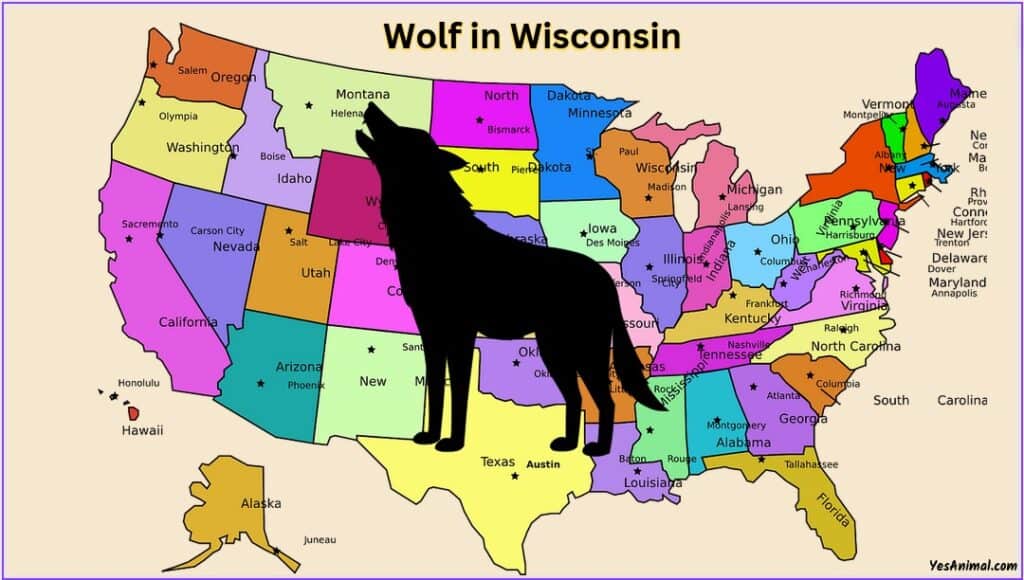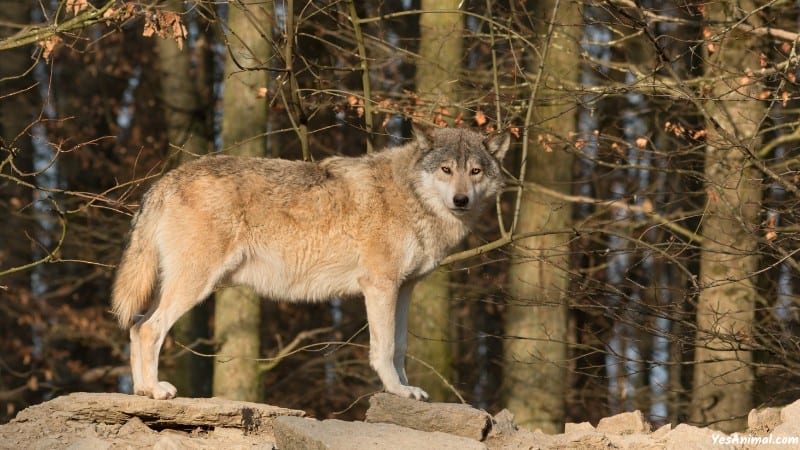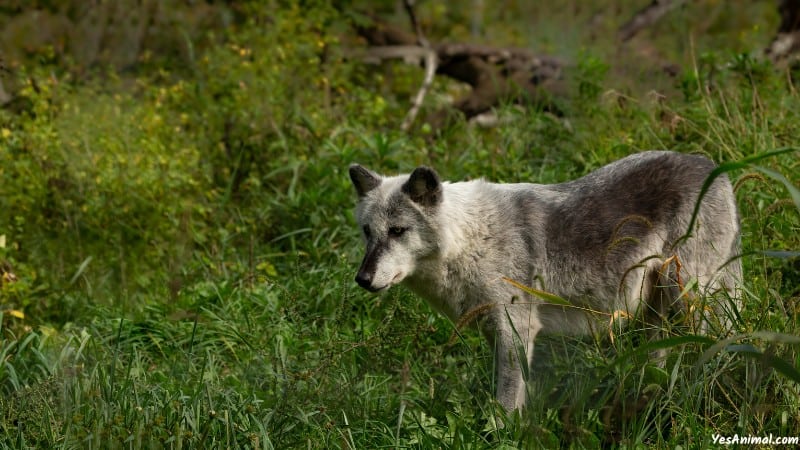Last Updated on September 14, 2023 by Amin Tawar

For Nature enthusiasts, Wisconsin is a perfect place to plan your next trip. The state is filled with many rivers, lakes, streams, forests, and wetlands. With such a diversity of habitats, it is no wonder the state is home to a wide range of wildlife which also includes wolves.
The state of Wisconsin is home to Gray wolves (Canis lupus) which are the largest canine in their species. These wolves are carnivores and prey on ungulates like deer, hares, etc. Currently found in northern and central parts of Wisconsin, the Gray wolves deviate towards forests with large areas.
Whether you are traveling to Wisconsin for a short stay or if you reside there, it is important that you have at least some knowledge about wolves in the state.
Below I’ve covered all the things you need to know about the wolves in Wisconsin.
Are There Wolf in Wisconsin?
Yes, there are wolfs in Wisconsin. In the early 1800s, after European settlement, many of the undulates like white-tailed deer, moose were extensively hunted and were nearly eliminated.
As wolves mostly preyed on undulates, scarcity of prey pushed the wolves to consume livestock. As a result of this, the state passed a bounty on wolves in 1865, which exterminated the wolf population across most of Wisconsin.
Even after the bounty was taken off in 1957, only a few wolves were remaining in the state concentrated in the far north region.
After federal protections like the inclusion of Gray wolves on the list of endangered species in 1974 and the rise of the wolf population in nearby states like Minnesota, wolves started coming back to Wisconsin, especially in the north-western part of the state.
Gradually, the wolf population started expanding across the northern and central parts of the state.
Where Are Wolves in Wisconsin?
Wisconsin is covered with forests, lakes, riverbeds, and wetlands which all are great habitats for Gray wolves.
As most of the northern part of the state consists of wide stretches of Forest, wetlands, and a relatively low population density, these habitats tend to be the most preferred by Gray wolves.
The historical range of wolves included areas from North Wisconsin to South till the Wisconsin Dells area.
However, due to the extensive hunting and killing of these beasts, most of the current wolf population is concentrated in the northern part of Wisconsin. Additionally, Grey wolves can also be found in various state parks across Wisconsin.
What Counties in Wisconsin Have Wolves?

Currently, wolves are known to reside in Ashland, Douglas, Bayfield, Burnett, Iron, Jackson, and other counties in the northern part of the state.
Gray wolves are pack hunters and often move from place to place in search of mates and prey. They have been recorded to travel for miles if the necessity arises.
With one of the strongest senses of smell, wolves can also be found beyond the counties mentioned above when hunting for prey.
Occasionally, they can be also found in other parts of the state however, they aren’t distributed equally throughout the state.
Also Check Our Guide On Wolves In US
How Many Wolves Are Left in Wisconsin?
As per the latest reports, there are about 900 to 1000 (in 2022) wolves living in the state of Wisconsin.
As per state Wolf monitoring reports, the wolf population has been rising in the last 30 years with a small dip in the last 2 years.
Wolves have also expanded their range within the state with a consistent presence in portions of northern and central forests which include these wolves’ historical range.
But there was a time when wolves population was roughly between 3000 to 5000 in the state of Wisconsin. After the European settlement, the wolf population dropped drastically due to scarcity of prey and issuing of bounties on wolves due to their predation on livestock.
Are Wolves A Problem in Wisconsin?
Though wolves stay away from humans, it is still important to be aware of their presence around you if you live or travel to the areas where wolves are known to reside.
Most of the time, the only reason a wolf may attack you is if you are in with livestock or pets both of which are preyed upon by wolves.
Opinions on wolves differ from person to person. For farmers and ranchers in the state, wolves are a threat to their livestock. However, most of the people in the suburbs are supportive of conserving these wolves and value them as an important part of Wisconsin’s natural heritage.
How Big Are Wolves in Wisconsin?
Though individual wolves vary in size based on many factors like environmental conditions, sex, etc., the wolves in Wisconsin are similar in size to the wolves in other states like Minnesota, Montana, and Michigan.
Wolves in Wisconsin typically weigh anywhere from 50 to 100 pounds and have a length from 5 to 7 feet.
Wolves are sexually dimorphic species which makes the adult male wolf larger than the female. An adult male wolf in Wisconsin weighs on average 75 pounds and a female weighs 60 pounds on average.
What Do Wolves Eat in Wisconsin?
A wolf’s feed largely depends on the prey existing in their surrounding environment, the time of the year, and competition from other predators.
Wisconsin is home to a diverse range of undulates from white-tailed deer to moose. These are some of the animals most preyed upon by wolves.
However, in winter when there is a scarcity of undulates, the wolves also feed on small mammals like rabbits, squirrels, carrions, and beavers.
Also check Our Guide On Wolves In Yellowstone
How Many Wolf Attacks Per Year in Wisconsin?
Generally, wolves avoid any contact with humans. But there have been only two confirmed reported incidents of wolf attacks in the past. One was when a small boy was attacked by a lone wolf and the other was when a group of campers were attacked by a pack of wolf.
However, most of the unreported attacks are due to their preying on livestock. Especially in winter, when the wolves are unable to locate prey in the wild, the wolves look to less densely populated human habitats for feeding on livestock.
Can You Own a Wolf in Wisconsin?
Wolf is a protected animal as per the state’s laws and therefore it is illegal for a person to own, breed or sell wolves in Wisconsin.
Though a valid permit from the Wisconsin Department of Natural Resources may allow a person to own a wolf, the process of getting the permit is very tedious.
Can You Shoot a Wolf in Wisconsin?
In Wisconsin, wolves are designated as federally endangered. Therefore, it is illegal to shoot a wolf in Wisconsin. However, if your life is under threat due to a wolf, you can shoot it as an act of self-defense.
Additionally, if your livestock is constantly killed by wolf predation, or if you find any wolve exhibiting dangerous behavior, you can report the incident to U.S. Wildlife Services.
Conclusion
And that was everything you need to know about the Wolves in Wisconsin. I hope this article answered all your queries.
Thank You For Reading!
Our Goto Source For This Guide
